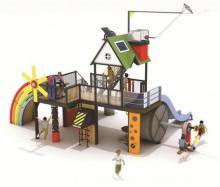
The Natural Energy Park is an experiential playground design that focuses on how movement, the sun, magnets, and water create power to operate different parts of the play equipment. Through moving a spinning wheel children can cause LEDs on a kite string to light up, and by pointing a solar panel toward or away from the sun they can cause the optical illusion plate to speed up or slow down.1
The playground design also utilizes the movement of pedaling a bicycle to show how kinetic energy is converted to electricity to either illuminate traffic lights or to be further converted to sound. As they pedal, the children can hear music from a radio through speakers on the column. Kinetic energy through a seesaw also turns a waterwheel, which leads to the slide component.
In the Natural Energy Park, a neodymium magnet uses repulsion power to suspend a small plane in the air, which the children control like pilots by using a control lever. The basic concepts of photography and light are illustrated by a pin-point camera, which the children can focus. A large videophone periscope connects the first and second floors and allows children to see each other and talk through the tube.2
This interactive Natural Energy Park design and model was created by You Song Young, Jin Soo Yeon, Ahn Ho Sang, and Lee Sung Jae from Hyundai Engineering and Construction.3 In 2010 it was a red dot design concept winner as best of the best in the Green category. The red dot design concept competition is an annual international recognition of excellence in designs and concepts.4
- 1. “Green.” reddot. < http://www.red-dot.sg/concept/porfolio/o_e/GR/B004.htm > 18 Aug. 2011.
- 2. Ibid.
- 3. “Natural Energy Park encourages children about science and energy.” Livbit. < http://www.livbit.com/article/2011/04/30/natural-energy-park-encourages-children-about-science-and-energy/ > 30 Aug. 2011.
- 4. “Welcome to the red dot award: design concept.” reddot. < http://www.red-dot.sg/concept/mrkt/marketing.html?&L=1 > 30 Aug. 2011.

